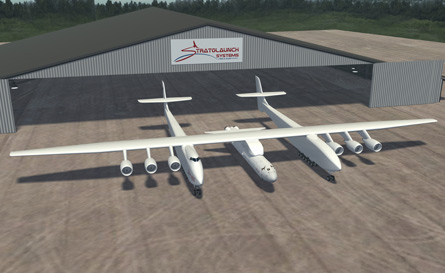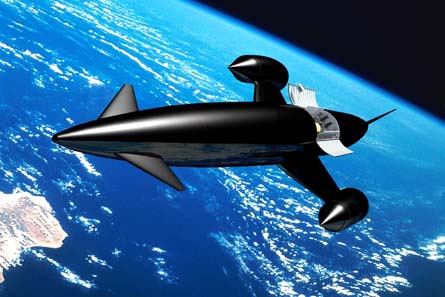For half a century, the most economical way of launching into orbit was to use an expendable multi-stage launch vehicle. Single-stage rockets simply did not have the performance or low enough structural weight to carry a significant payload to orbital velocity.
However, designers knew that expendable rocket engines and stages do not come cheap, even with a production line, and that a having a reusable rocket would be ideal.
 |
|---|
Stratolaunch Two ex-United Airlines 747s chopped into a heavyweight carrier form the basis of Stratolaunch's air-drop concept |
Enter the Space Shuttle. While a fully reusable concept was initially defined for it, in 1972 this was downgraded to a more affordable "mainly reusable" concept. It was this very reusability that, combined with the man-rated requirement, caused a major increase in operational costs. The requirement to strip down the rocket engines and do extensive checking of the tiled thermal-protection system after every mission increased the launch cost and reduced turnaround times. These factors also conspired to give the Space Shuttle such a low flight rate that the partially reusable system nearly became the most expensive launch vehicle ever to fly. Only the Saturn V and the Titan IV expendable rockets were more costly on a per-launch basis.
As expendable rocket systems reach maturity, rocket designers are examining what should come next. Despite past failures, the dream of having airline style operations with launch vehicles achieving high utilisation continues to intrigue engineers.
Advances in materials and engine technologies led some designers to consider that single-stage-to-orbit reusable operations could be possible. After flirting with a jet-scramjet-rocket design called the National Aerospace Plane (NASP) and its scramjet-powered X-30 prototype, NASA came up with the X-33 VentureStar precursor - a vertically launched/horizontal-landing test vehicle using novel aerospike rocket and composite tank technologies - and supported the further development of a lightweight aeroshell vertical-launch/vertical-landing test design called Delta Clipper (DC-X) by McDonnell Douglas. Of this latter pair, the suborbital DC-X flew, showing that vertical rocket-powered landings could be achieved. However, technology failures, combined with payload limitations, meant derivative single-stage-to-orbit reusable systems were unlikely to become a reality, and both programmes were cancelled. Nevertheless, the dream of economic reusable launch vehicles persists.
The main way of achieving this is to use air-breathing propulsion for horizontal take-offs and landings with wings. This is a way of increasing the specific impulse of an engine in the early part of the flight, reducing the need to carry heavy oxygen into orbit, making possible a high flight rate. Any air-breathing vehicle needs a shallow trajectory - which means using wings, which add extra weight. However, wings allow for benign lift-off, landing, and abort procedures.
 |
|---|
Skylon The Skylon concept hopes to realise HOTOL's 1980s dream of a resueable spaceplane |
Jet engines are very efficient during the air-breathing phase, though they can only really be used up to about Mach 3. Ramjets are light and work well, but only have limited Mach range (Mach 1-5) and have to be boosted initially to work. Scramjets (supersonic combustion ramjets) also need to be boosted. As efficient as air-breathing concepts are, once atmospheric oxygen runs out a rocket system is needed for orbital injection.
A designer named Alan Bond, then working for Rolls-Royce, teamed with British Aerospace to design HOTOL (horizontal take-off and landing). This concept used an air-breathing cycle with a rocket engine at its core. The idea was to use a "pre-cooler" heat exchanger to cool intake air to where it could be compressed and injected directly into the engine's rocket thrust chamber for the early part of the flight. Later in the flight, the engines would convert to rocket power only. Having got to Mach 5 using air breathing, the vehicle would need much less onboard oxygen to achieve orbital velocity on rocket power. This, in conjunction with lightweight aeroshell thermal-projection systems, promised a practical single-stage reusable vehicle.
OVERWEIGHT
Nevertheless, The HOTOL spaceplane design had some fundamental faults: the intake was large and heavy, and placing the rocket engines at the rear of the vehicle meant that large trimming devices were needed for centre-of-lift/centre-of-gravity mismatches. All this extra weight meant that HOTOL could not actually carry a positive payload.
Having broken away from Rolls-Royce, Bond and fellow designer Richard Varvill set up Reaction Engines to improve the concept. The firm came up with the Skylon design, which addressed the design problems of HOTOL, moving the location of the engines.
Reaction Engines is now testing the "pre-cooler" heat exchanger. If tests are successful, the next phase includes building a small-scale flight vehicle to test the aerodynamics and intake design.
While the ESA has backed research in the mainly privately-funded project, politics may yet end this support. France, via its Arianespace interests, has long dominated ESA's launch programme and is likely to prefer to building a modular expendable rocket called Ariane 6 as the next European launch vehicle.
Nevertheless, other space agencies and organisations are interested in Skylon's air-breathing technologies - including NASA, which sent rocket experts to Skylon's technical review in 2010. Meanwhile, Japan's space agency JAXA continues to work on similar heat-exchange systems via its ATREX air-turbo ramjet programme.
SpaceX and Blue Origin prefer vertically launched reusable two-stage launch vehicles. Two-stage, vertically launched winged rocket systems (such as the Space Shuttle's original design) and horizontally launched two-stage types have been studied in the past, but most two-stage systems now being considered employ two wingless, vertically launched stages using conventional rocket propulsion. This effort is now being led mainly by private companies as they examine systems to carry manned capsules and unmanned spacecraft to orbit.
 |
|---|
SpaceX SpaceX is working on a reuseable stage based on its Falcon 9 vehicle |
Amazon billionaire Jeff Bezos formed Blue Origin to build systems to compete to launch humans and materials into orbit. Blue Origin plans to have a first stage landing vertically on a seaborne landing pad/aircraft carrier. Only the first stage is set to be reusable, with the upper one being expendable. The reusable launch vehicle will eventually be used for a bi-conic manned-capsule design, but only after the capsule has been launched on an expendable Atlas V.
Meantime, Blue Origin has been working on a suborbital reusable stage dubbed New Shepard by which to mature techniques and hardware. Its test regime had to be temporarily halted after a failure destroyed the craft in August 2011.
Space Exploration Technologies (SpaceX), under the leadership of Elon Musk, has been examining how to perform reusable launches. It plans to have two vertically launched, vertically landing main reusable stages. Any manned/unmanned capsule carried might also be reusable.
SpaceX's concept uses a first-stage derivative of the Falcon 9, which would be launched on a suborbital trajectory with the second stage and capsule/service module attached above it. After the second stage separates to fly into orbit, the first stage will be aimed back towards the launch site and make an engine firing to return from its position down range. After a ballistic approach, the stage will stabilise to an engine-down position and land vertically.
Meantime, the reusable Falcon 9 second stage would deliver its payload into orbit, and on the next close pass it would re-enter and also land vertically back at the base. While this would not be as difficult to achieve as it would for a single-stage rocket-powered vehicle, doubts remain about the extra weight needed for the stages' thermal-protection systems and about the mass of fuel required for their rocket-based landings.
DROP EVERYTHING
A third route to reusability would be to go partially reusable, using winged rocket boosters. The US Air Force's plan to replace the evolved expendable launch vehicles Atlas V and Delta IV rockets with a successor that will be at least partially reusable is gaining traction. While commercial space launch firms are apparently plumping for rocket-powered vertical touchdowns, the concept of horizontal landings for vertically launched rockets - at least for the initial boosters - remains attractive to military and government operators.
There is also the option of dropping a partially reusable rocket from a reusable "Stage 0" aircraft. Since 1990 Orbital Sciences' Pegasus expendable four-stage solid-rocket winged vehicle has been dropped from a B-52 bomber or a modified Lockheed L-1011 Tristar passenger jet. The idea is that being released at high altitude and with a 500kt velocity increment from the aircraft reduces the amount of energy needed to make a climb to orbit.
Other firms have examined air-dropping for rocket launches. Most recently, the Stratolaunch system was announced. This will use a six-engined carrier aircraft developed by Scaled Composites that will drop-launch a scaled-down, probably reusable version of the SpaceX Falcon 9 rocket. Whether such a vehicle is practical remains to be seen, but the Stratolaunch firm enjoys access to serious capital and appears to be proceeding at a rapid pace.
In a separate development, Boeing is now also examining an air-dropped concept for a multi-stage air-breathing small-satellite reusable launcher. This launch vehicle would employ two air-breathing delta-winged/waverider stages using jet and scramjet propulsion respectively, followed by a conventionally powered rocket third stage (which itself might also be reusable) to finally achieve orbit.
Whichever route is chosen, launch operators will be careful not to let manned operations skew the operating economics of their reusable launch vehicles. There are signs that NASA is sympathetic to this as it concentrates on its requirements for manned launch-escape systems rather than trying for the unattainable mirage of the total reliability and systems redundancy for the launch vehicles that will carry its astronauts.
Source: Flight International


























